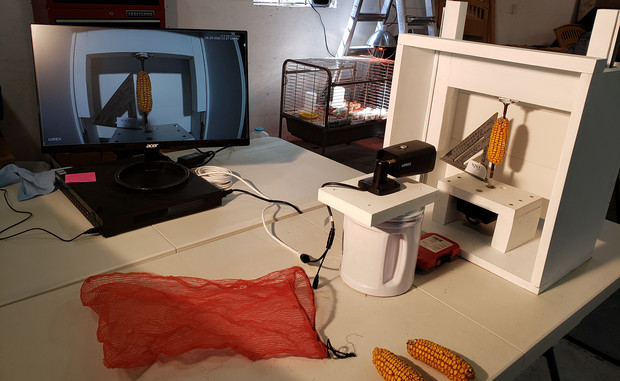Center for Root and Rhizobiome Innovation
Troy Fedderson, May 6, 2020
Home-built scanner keeps maize study spinning forward
A pivot by Nebraska’s Brandi Sigmon is helping a multi-season maize study move forward despite COVID-19-related limitations.
Working from home in rural Gage County, Sigmon teamed with her husband and fellow University of Nebraska–Lincoln faculty member, Benny Mote, to build a corn ear scanner. The weekend project is now being used to record detailed, 360-degree videos of individual ears, which can be converted to 3D and 2D images for study.
“The scanner allows us to study ears from all angles,” Sigmon said. “We’re able to take those images and, with the assistance of computer code, reconstruct each ear and gather all sorts of data on the traits we are interested in.
“It’s more efficient and has greater accuracy than measuring by hand.”

The project is part of a two-year study by the university’s Center for Root and Rhizobiome Innovation. It seeks to examine how some 200 varieties of maize respond to various soil conditions, primarily low soil nitrogen and water stress. Ultimately, the project hopes to advance understanding into how crops like maize can impact rhizobiomes (the microbes in the soil around the roots) and — possibly — show which maize varieties produce root exudates (secreted substances) that result in greater success in challenging growing conditions.
“It boils down to how the genetics of maize is an important factor in recruiting different microbial communities, which in turn influences growth and health under stress conditions,” Sigmon said.
While a necessary tool for the study, the scanner project had been put on the backburner as the team worked on other elements of the study and prepared for the upcoming growing season. When Sigmon learned that the lab would shut down as part of the university’s response to COVID-19, she decided to make the most of the work-from-home period.
“I knew this scanning was something that we could definitely accomplish from home,” Sigmon said. “So, I went in before the lab closed, grabbed the nearly 2,000 ears from last season and we built the scanner as part of a family project over a weekend.”
Sigmon and Mote, an assistant professor of animal science and a swine specialist with Nebraska Extension, used blueprints provided by a researcher at Oregon State University for the build. Mote’s expertise in using cameras to track swine with the NUtrack Livestock Monitoring team also proved useful.
“Once we get the algorithms refined in the computer code, this scanner will definitely help keep this research moving forward,” Sigmon said. “I think that’s part of our duty as faculty, to model resilience and grit. When faced with challenges, we need to find those open doors that allow for progress, even if it’s incremental.”





